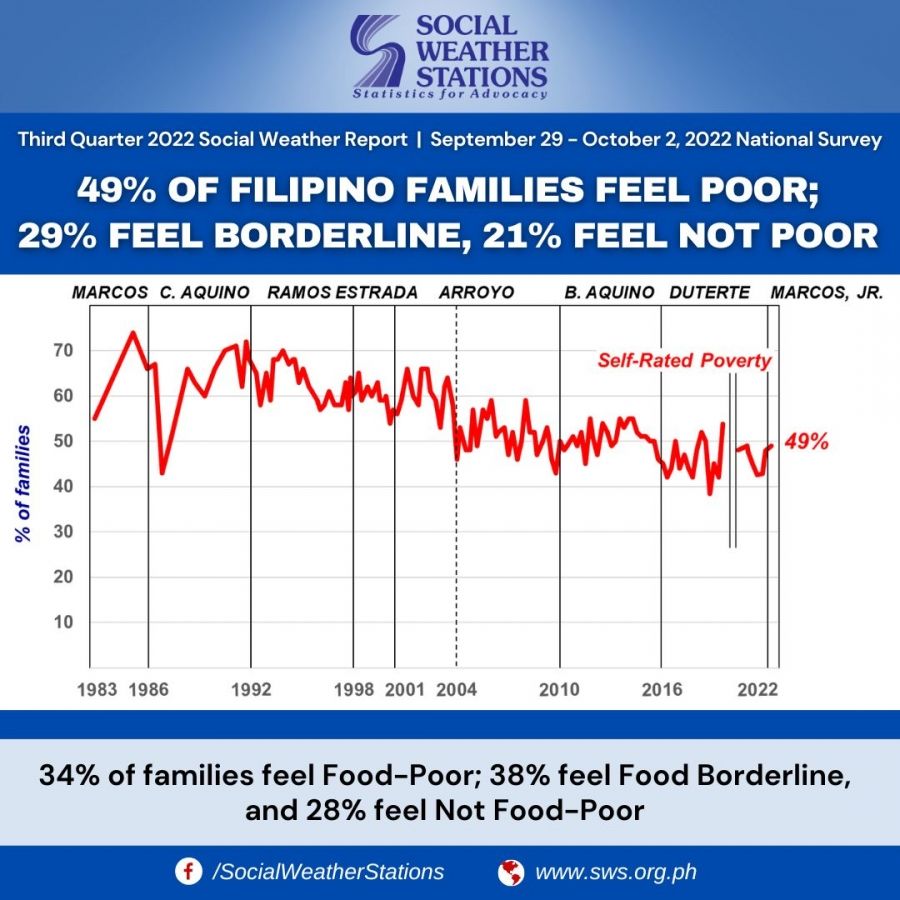
by Social Weather Stations
- 34% of families feel Food-Poor; 38% feel Food Borderline, and 28% feel Not Food-Poor
The national Social Weather Survey of September 29 – October 2, 2022, the first under the administration of President Ferdinand “Bongbong” Marcos, Jr., found 49% of Filipino families rating themselves as Mahirap or Poor, 29% rating themselves as Borderline (by placing themselves on a horizontal line dividing Poor and Not Poor), and 21% rating themselves as Hindi Mahirap or Not Poor.
Compared to June 2022, the percentage of Poor families hardly moved from 48%, while Borderline families fell slightly from 31%, and Not Poor families stayed at 21% [Charts 1-2, Table 1].
The estimated numbers of Self-Rated Poor families are 12.6 million in October 2022 and 12.2 million in June 2022.
SWS has measured Self-Rated Poverty (SRP) quarterly through face-to-face (F2F) surveys since 1992, except in the first three quarters of 2020 when F2F was not possible for lack of public transportation during the pandemic. SWS resumed the SRP surveys in the 4th quarter of 2020, up to the present.
Self-Rated Poor rises in all areas except in Balance Luzon
The 1-point rise in the nationwide Self-Rated Poor between June 2022 and October 2022 was due to slight increases in the Visayas, Metro Manila, and Mindanao, combined with a steady percentage in Balance Luzon (or Luzon outside Metro Manila) [Charts 3-4, Table 2].
Compared to June 2022, Self-Rated Poor rose slightly in the Visayas from 64% to 68%, in Metro Manila from 41% to 44%, and in Mindanao from 62% to 64%. It stayed at 36% in Balance Luzon.
On the other hand, Borderline fell slightly in the Visayas from 26% to 21%, in Mindanao from 31% to 28%, and in Balance Luzon from 36% to 35%. It hardly moved in Metro Manila from 22% to 23%.
At the same time, Not Poor hardly moved in Balance Luzon from 28% to 29%, in the Visayas from 10% to 11%, and in Mindanao from 7% to 8%. It fell in Metro Manila from 37% to 33%.
34% of families feel Food-Poor; 38% feel Food Borderline, and 28% feel Not Food-Poor
On Self-Rated Food Poverty, based on the type of food eaten by their families, the October 2022 survey found 34% of families rating themselves as Food-Poor, 38% rating themselves as Food Borderline (by placing themselves on the horizontal line dividing Food-Poor and Not Food-Poor), and 28% rating themselves Not Food-Poor [Charts 5-6, Table 3].
Compared to June 2022, the percentage of Food-Poor families stayed at 34%, Food Borderline families fell slightly from 40%, and Not Food-Poor families rose slightly from 26%.
The estimated numbers of Self-Rated Food Poor families are 8.7 million in both October 2022 and June 2022.
Food-Poor rises in all areas except in Balance Luzon
The steady Self-Rated Food-Poor percentage from June 2022 to October 2022 was due to increases in the Visayas, Mindanao, and Metro Manila, combined with a decrease in Balance Luzon [Charts 7-8, Table 4].
Compared to June 2022, Self-Rated Food-Poor rose in the Visayas from 37% to 44%, in Mindanao from 45% to 50%, and in Metro Manila from 31% to 33%. However, it fell in Balance Luzon from 28% to 22%.
On the other hand, Food Borderline fell in the Visayas from 44% to 34%, in Mindanao from 46% to 39%, and in Metro Manila from 28% to 24%. It rose in Balance Luzon from 38% to 44%.
At the same time, Not Food-Poor rose slightly in Metro Manila from 41% to 43%, in the Visayas from 19% to 22%, and in Mindanao from 9% to 11%. It stayed at 34% in Balance Luzon.
Self-Rated Poverty Threshold rises in Metro Manila and Mindanao; it falls in the Visayas and stays the same in Balance Luzon
In the last three quarters, the national median Self-Rated Poverty Threshold (SRP Threshold) stayed at P15,000, while the national median Self-Rated Poverty Gap (SRP Gap) stayed at P6,000 [Chart 9, Table 5].
In Metro Manila, the median SRP Threshold rose from P15,000 to P20,000, while the median SRP Gap rose from P5,000 to P9,000 [Chart 10, Table 6].
In Balance Luzon, the median SRP Threshold stayed at P15,000, while the median SRP Gap fell from P7,000 to P5,000 [Chart 11, Table 7].
In the Visayas, the median SRP Threshold fell from a record-high P20,000 to P15,000, while the median SRP Gap fell from P9,000 to P6,000 [Chart 12, Table 8].
In Mindanao, the median SRP Threshold rose from P10,000 to P15,000, while the median SRP Gap rose from P5,000 to P7,000 [Chart 13, Table 9].
The SRP Threshold, or the minimum monthly budget self-rated poor families say they need for home expenses in order not to consider themselves poor, has remained sluggish for several years despite considerable inflation. This indicates that poor families have been lowering their living standards, i.e., belt-tightening.
In the past, the median SRP Gap has generally been half of the median SRP Threshold. This means that average poor families lack about half of what they need to not consider themselves as poor. An increase in the proportion of the median SRP Gap relative to the median SRP Threshold means a worsening in families’ budget for home expenses.
Self-Rated Food Poverty Threshold rises to record-high in Mindanao; it rises in Metro Manila but falls in Balance Luzon and the Visayas
In the last three quarters, the national median Self-Rated Food Poverty Threshold (SRFP Threshold) stayed at P8,000, while the national median Self-Rated Food Poverty Gap (SRFP Gap) stayed at P3,000 [Chart 14, Table 10].
In Metro Manila, the median SRFP Threshold rose from P9,000 to P10,000, while the median Gap rose from P3,000 to P4,000 [Chart 15, Table 11].
In Balance Luzon, the median SRFP Threshold fell from a record-high P10,000 to P8,000, while the median Gap fell from P4,500 to P3,000 [Chart 16, Table 12].
In the Visayas, the median SRFP Threshold fell from a record-high P10,000 to P6,000, while the median SRFP Gap fell from P4,000 to P3,000 [Chart 17, Table 13].
In Mindanao, the median SRFP Threshold rose from P6,000 to a new record-high P9,500, while the median SRFP Gap rose from P3,000 to P4,000 [Chart 18, Table 14].
7.7% of families are “newly poor”
The October 2022 survey asked the Self-Rated Poor if they ever experienced being non-poor (either not poor or borderline) in the past. The total percentage of poor families consists of 7.7% who were non-poor 1-4 years ago (“Newly Poor”), 4.0% who were non-poor five or more years ago (“Usually Poor”), and 37.7% who never experienced being non-poor (“Always Poor”) [Chart 19, Table 15].
Of the estimated 12.6 million Self-Rated Poor families in October 2022, 2.0 million were Newly Poor, 1.0 million were Usually Poor, and 9.6 million were Always Poor.
Conversely, the survey asked those who were Self-Rated Non-Poor (either Borderline or Not Poor) if they ever experienced being poor in the past. The total percentage of non-poor families consists of 18.9% who were poor 1-4 years ago (“Newly Non-Poor”), 8.0% who were poor five or more years ago (“Usually Non-Poor”), and 23.6% who never experienced being poor (“Always Non-Poor”).
Of the estimated 12.9 million Self-Rated Non-Poor families in October 2022, 4.8 million were Newly Non-Poor, 2.0 million were Usually Non-Poor, and 6.0 million were Always Non-Poor.
Survey background
The Third Quarter 2022 Social Weather Survey was conducted from September 29 – October 2, 2022, using face-to-face interviews of 1,500 adults (18 years old and above) nationwide: 300 each in Metro Manila, the Visayas, and Mindanao, and 600 in Balance Luzon. Face-to-face is the standard interviewing method for Social Weather Stations; the only exceptions were early in the pandemic when movement restrictions made face-to-face impossible and mobile phone interviews were conducted. Normal face-to-face field operations resumed in November 2020. The sampling error margins are ±2.5% for national percentages, ±5.7% each for Metro Manila, the Visayas, and Mindanao, and ±4.0% for Balance Luzon.
The area estimates were weighted by the Philippine Statistics Authority medium-population projections for 2022 to obtain the national estimates.
The SWS survey questions about Self-Rated Poverty and Self-Rated Food Poverty are directed to household heads. These items are non-commissioned and are included on SWS’s initiative and released as a public service.
In 2020, Self-Rated Poverty and Self-Rated Food Poverty were fielded only once because only in November 2020 was SWS able to resume face-to-face interviewing since the Covid-19 pandemic struck. Face-to-face interviewing is necessary for these questions since they require showing the respondents a card with the words MAHIRAP and HINDI MAHIRAP, separated by a LINE, written on it [Figure 1]. The three SWS Mobile Phone Surveys earlier that year implemented purely oral survey questions.
The exact phrasing of the survey questions (the source language is Filipino; English translation included) was:
For Self-Rated Poverty:“Saan po ninyo ilalagay ang inyong pamilya sa kard na ito? [Where would you place your family in this card?]”
Half of the respondents are shown a card with the choices HINDI MAHIRAP (Not poor) and MAHIRAP (Poor), separated by a horizontal line (recorded as ‘Borderline), while the other half are shown a card containing the reverse order (negative showcard), to lessen response bias.
Figure 1. Self-Rated Poverty Showcard
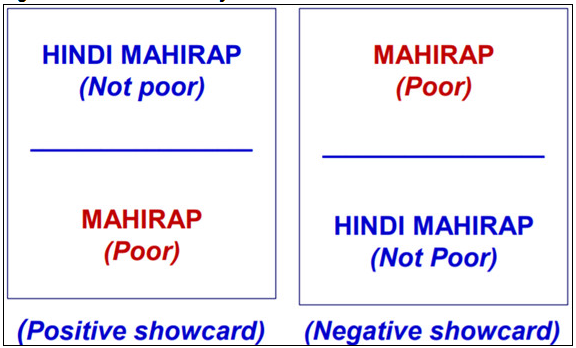
To arrive at the estimated numbers of Self-Rated Poor families, the percentage of respondent households rating themselves as poor was applied to the Philippine Statistics Authority medium-population projections for 2022.
For Self-Rated Poverty Threshold (SRP Threshold): “KUNG MAHIRAP: Upang hindi na masabing mahirap kayo, magkano sa palagay ninyo ang pinakamababang panggastos sa bahay sa isang buwan na kailangan ng inyong pamilya? Hindi po kasama ang mga gastusin na may kinalaman sa trabaho tulad ng pamasahe. [IF POOR: In your opinion, how much money would your family need for home expenses each month in order not to be called poor anymore? This excludes work-related expenses like transportation.]”
For Self-Rated Poverty Gap (SRP Gap): “KUNG MAHIRAP: Sinabi po ninyo na P(MENTION ANSWER) ang pinakamababang panggastos sa bahay sa isang buwan na kailangan ng inyong pamilya upang hindi na masabing mahirap kayo. Magkano pa po ba ang kulang ninyo sa ngayon? [IF POOR: You said that P(MENTION ANSWER) is the amount of money that your family would need for home expenses each month in order not to be called poor anymore. How much DO YOU LACK now?]”
The SRP Threshold is the minimum monthly budget self-rated poor families say they need for home expenses in order not to consider themselves as poor. The SRP Gap is how much self-rated poor families they lack in their minimum monthly budgets relative to their SRP Threshold.
The SRP Threshold and SRP Gap are presented in this report in terms of their medians which is the amount that addresses only the requirements of the poorer half of the poor. An increase in the proportion of the median Gap relative to the median Threshold means a worsening in families’ budget for home expenses.
For Self-Rated Food Poverty: “Tungkol naman sa klase ng pagkain ng pamilya ninyo, saan po ninyo ilalagay ang inyong pamilya sa kard na ito? [Based on the type of food eaten by your family, where would you place your family on this card?]” Respondents are shown a similar showcard with the choices HINDI MAHIRAP (recorded as Not Food-Poor) and MAHIRAP (recorded as Food-Poor), separated by a horizontal line (recorded as Borderline Food-poor). The same split-sample approach using positive and negative showcards is implemented to lessen response bias.
For Self-Rated Food Poverty Threshold (SRFP Threshold): “KUNG MAHIRAP: Upang hindi na masabing mahirap kayo, batay sa pagkain, magkano sa palagay ninyo ang pinakamababang panggastos sa pagkain sa isang buwan na kailangan ng inyong pamilya? [IF POOR: In your opinion, how much money would your family need for food expenses each month in order not to be called poor anymore in terms of food?]”
Finally, for Self-Rated Food Poverty Gap (SRFP Gap): “KUNG MAHIRAP: Sinabi po ninyo na P(MENTION ANSWER) ang pinakamababang panggastos sa pagkain sa isang buwan na kailangan ng inyong pamilya upang hindi na masabing mahirap kayo batay sa pagkain. Magkano pa po ba ang kulang ninyo sa ngayon? [IF POOR: You said that P(MENTION ANSWER) is the amount of money that your family would need for food expenses each month in order not to be called poor anymore in terms of food. How much DO YOU LACK now?]”
The SRFP Threshold is the minimum monthly food budget the food-poor families say they need in order not to consider their type of food as poor. The SRFP Gap is how much food-poor families lack relative to their stated SRFP threshold.
The SRFP Threshold and SRFP Gap are presented in this report in terms of their medians which is the amount that addresses only the requirements of the poorer half of the food-poor. An increase in the proportion of the median Gap relative to the median Threshold means a worsening in families’ food budgets.
SWS employs its own staff for questionnaire design, sampling, fieldwork, data processing, and analysis, and does not outsource any of its survey operations. This report was prepared by Leo S. Laroza and Marvin R. Ipac.
Chart 1

Chart 2
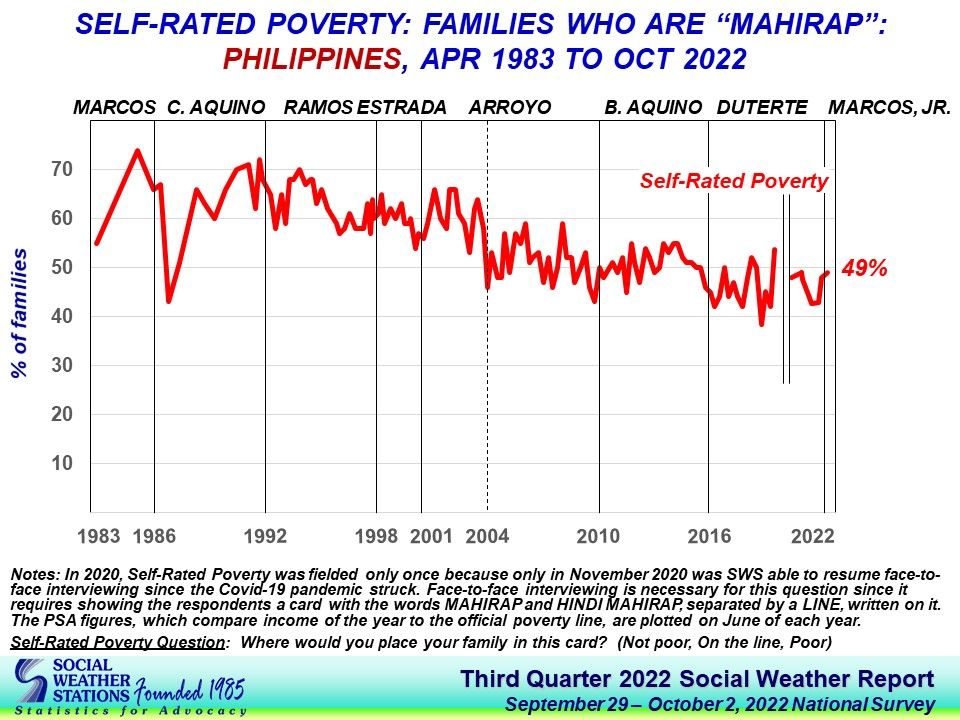
Table 1
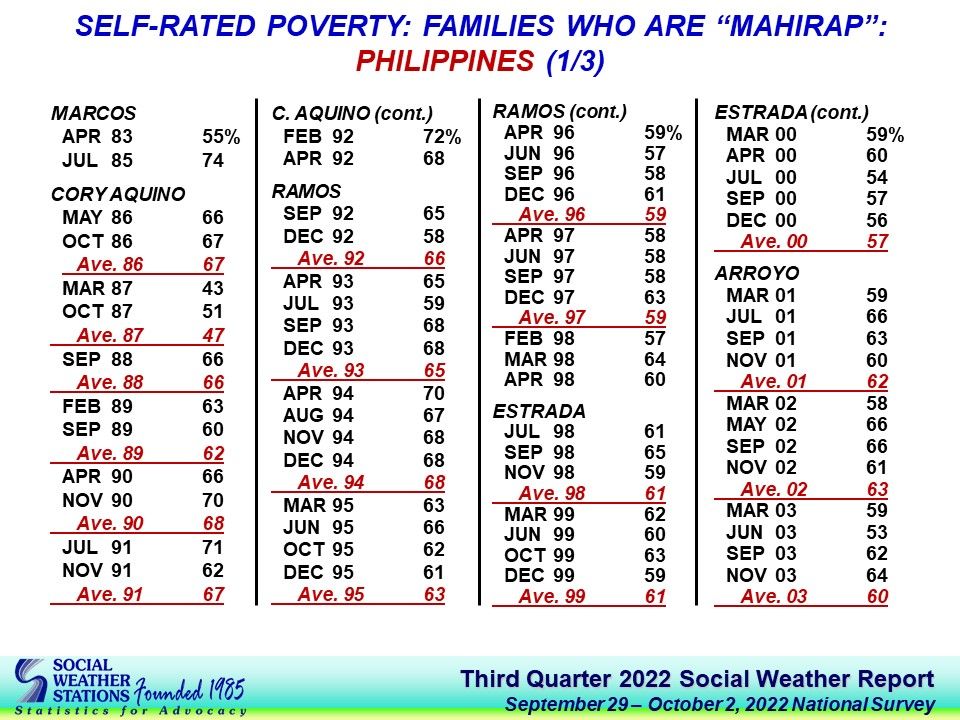
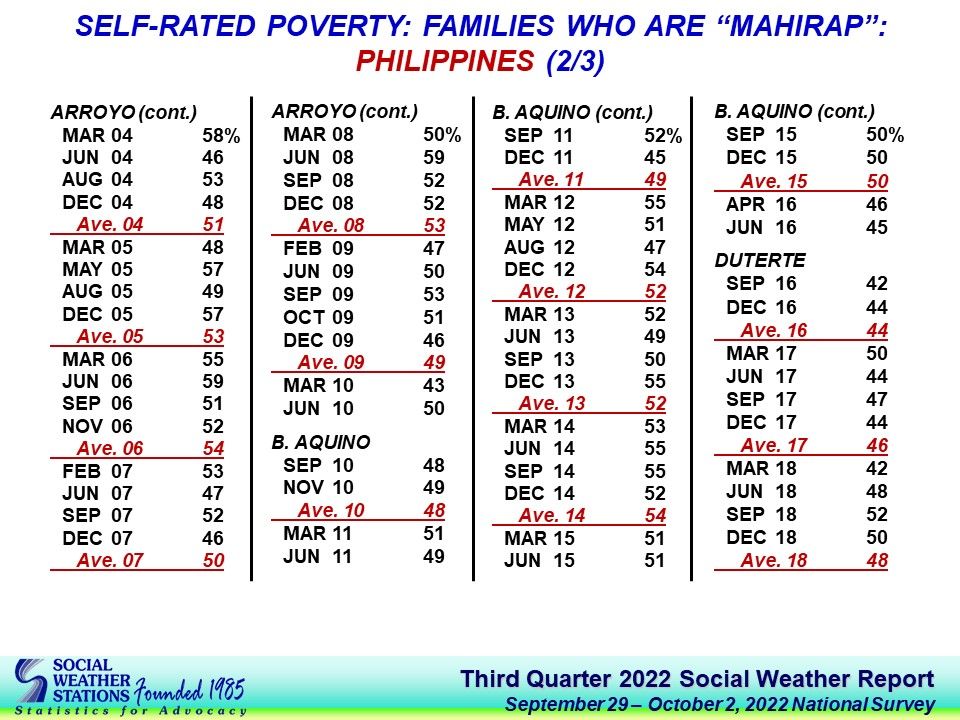
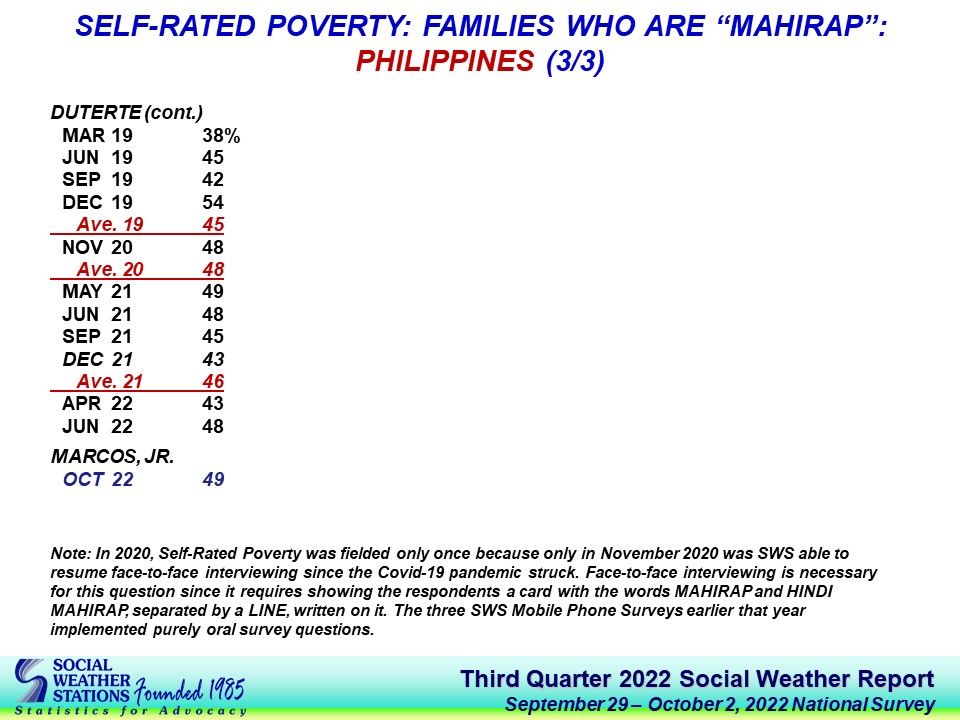
Chart 3
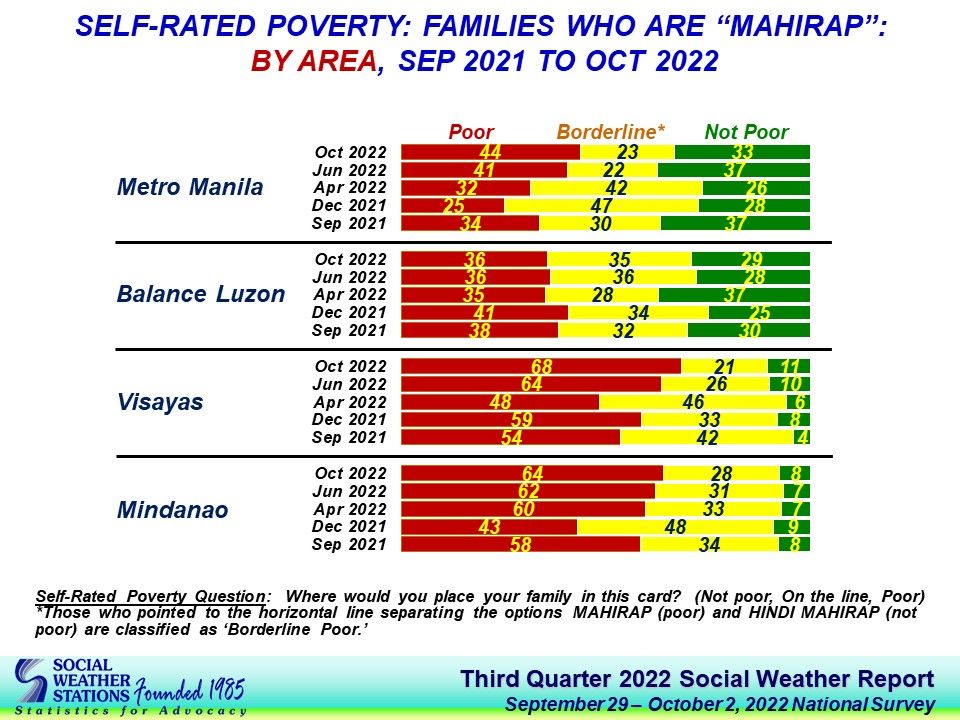
Chart 4
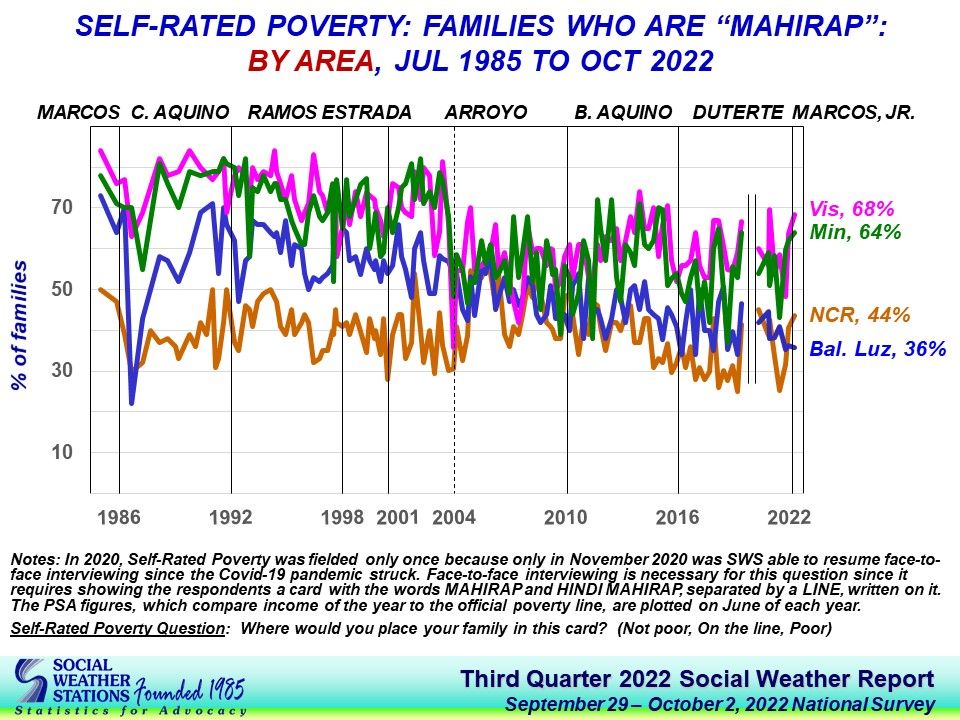
Table 2
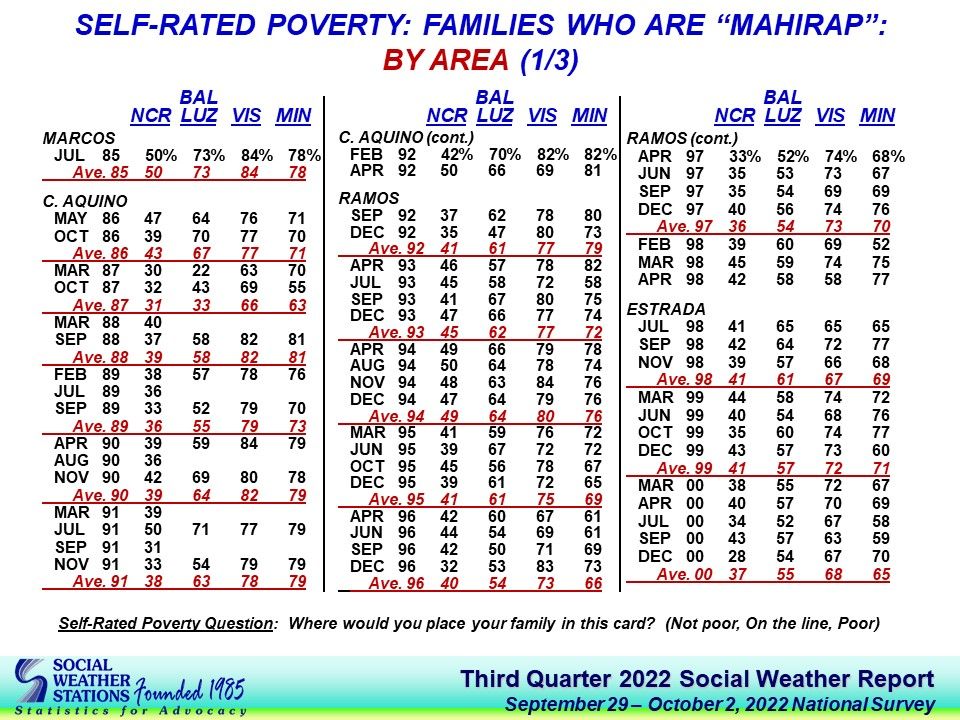
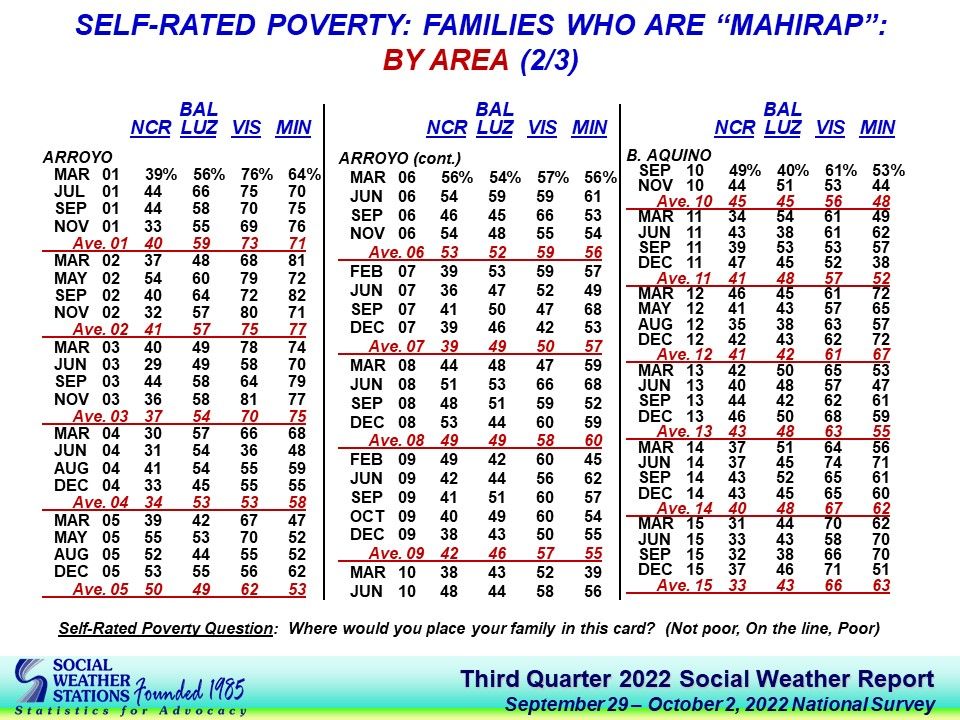
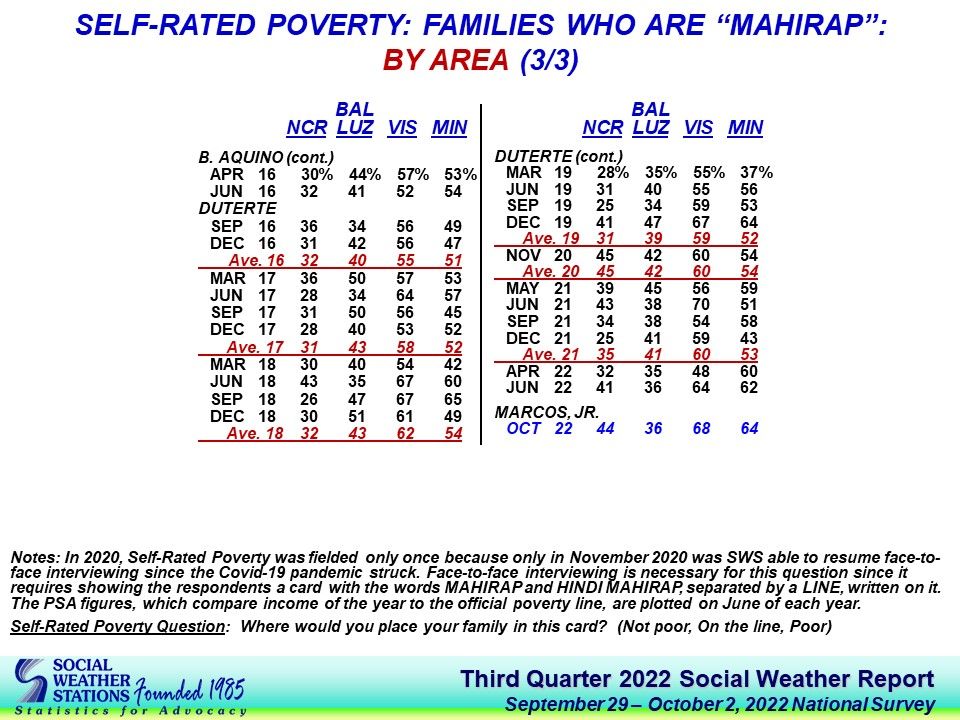
Chart 5

Chart 6

Table 3
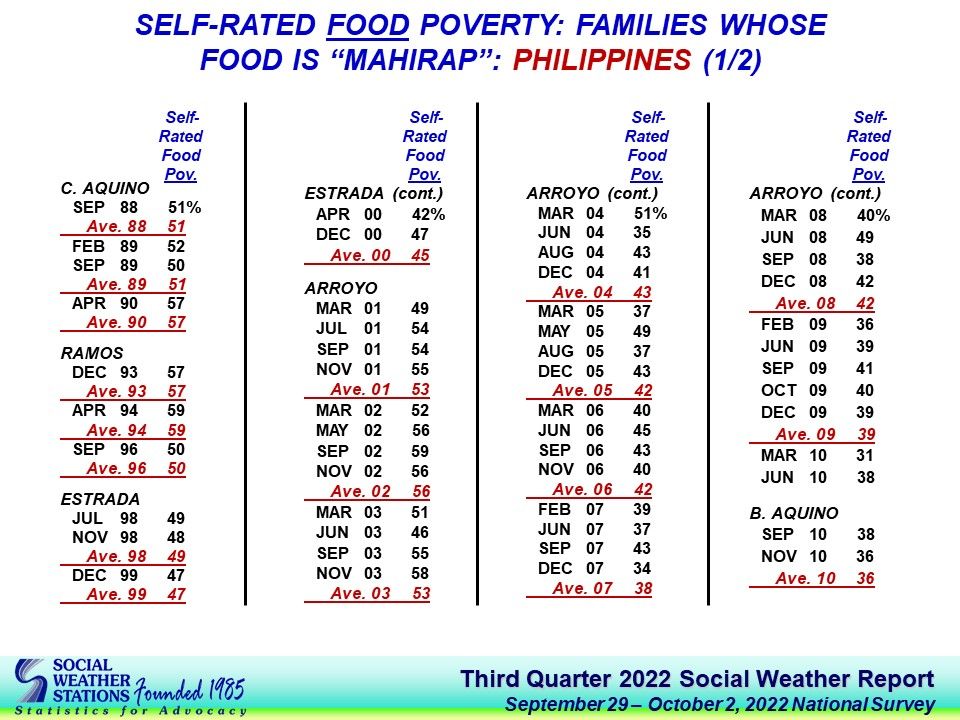
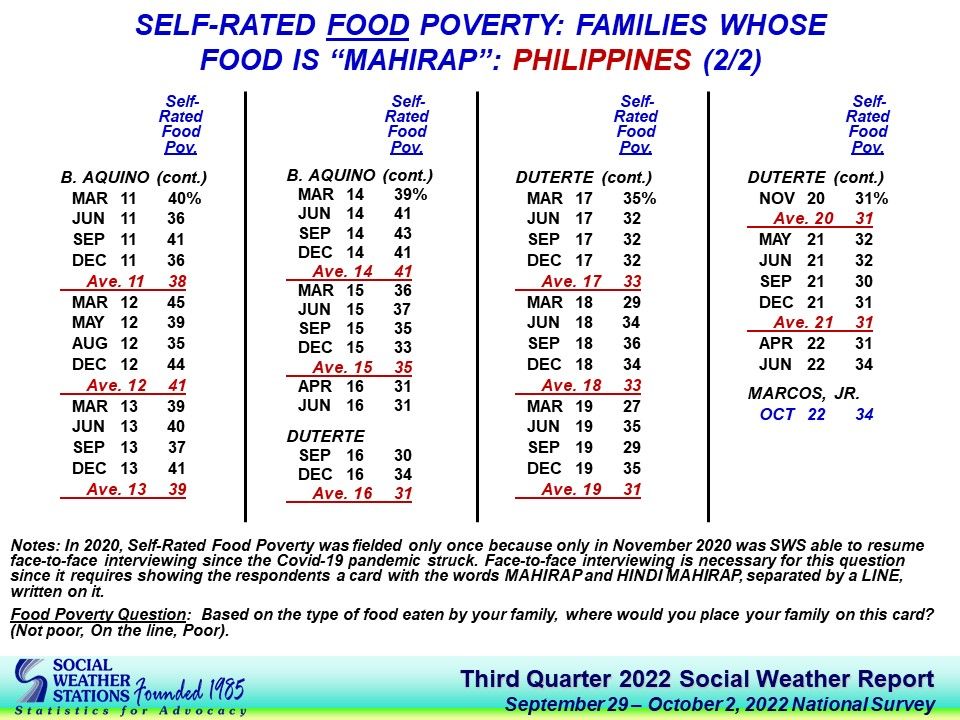
Chart 7

Chart 8

Table 4
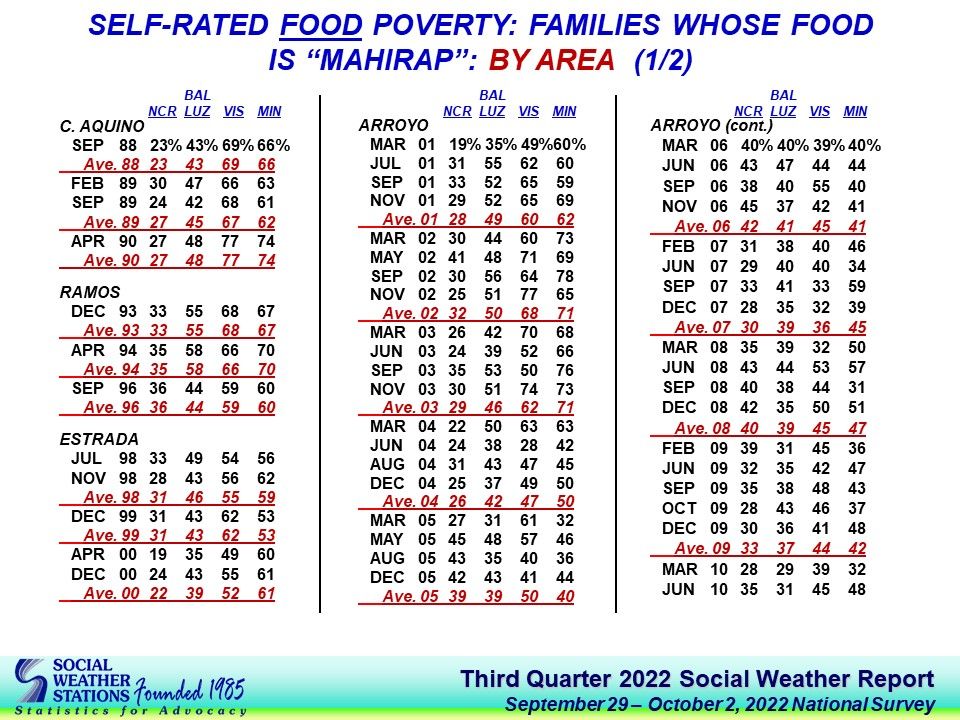
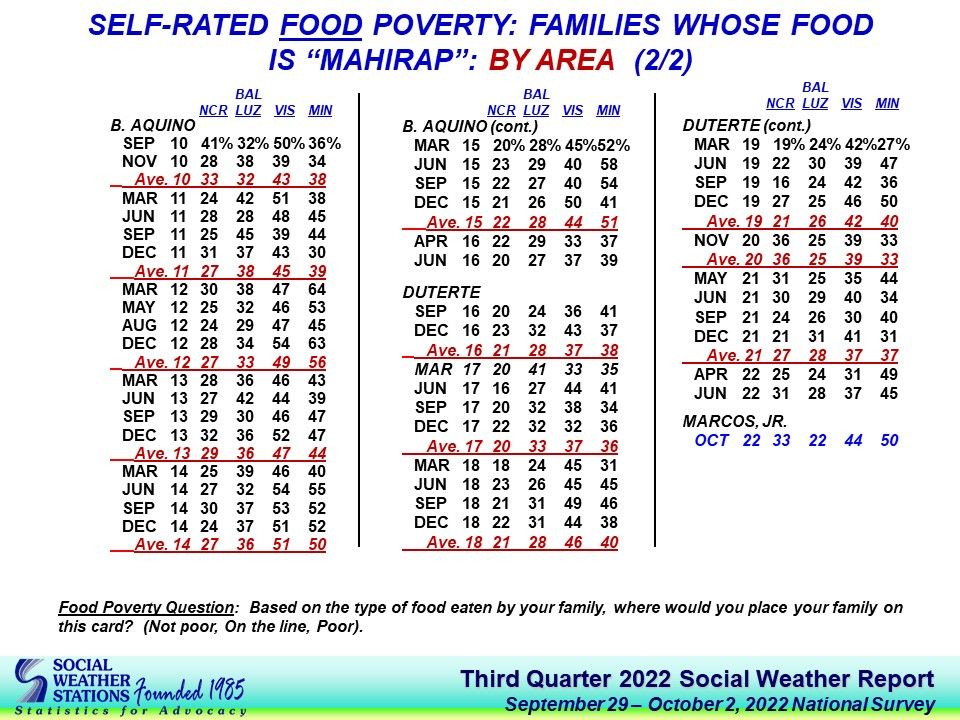
Chart 9
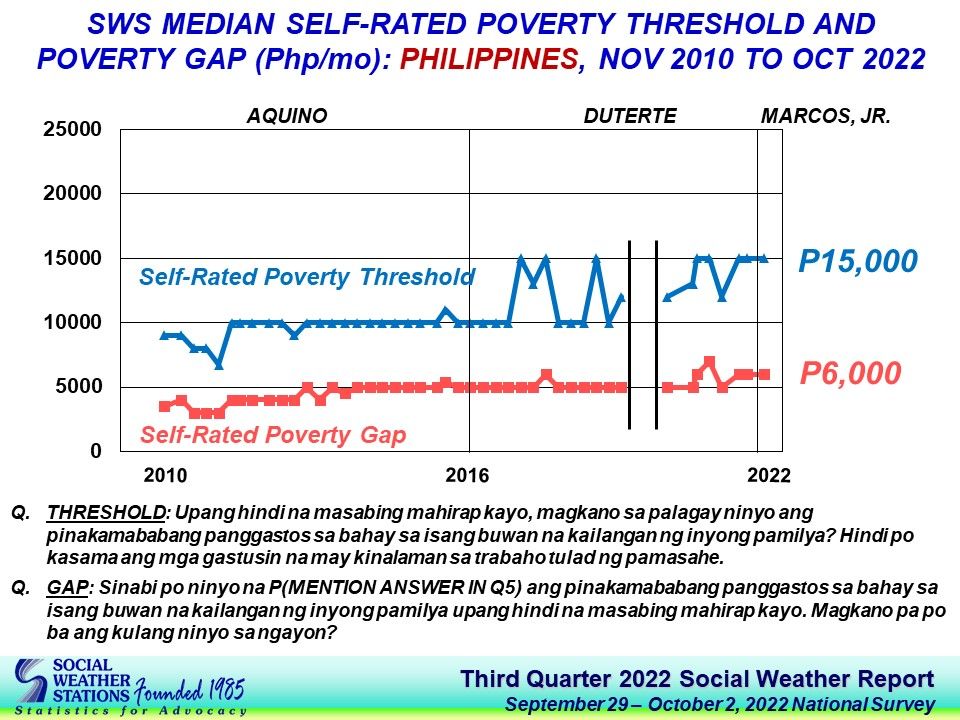
Table 5

Chart 10
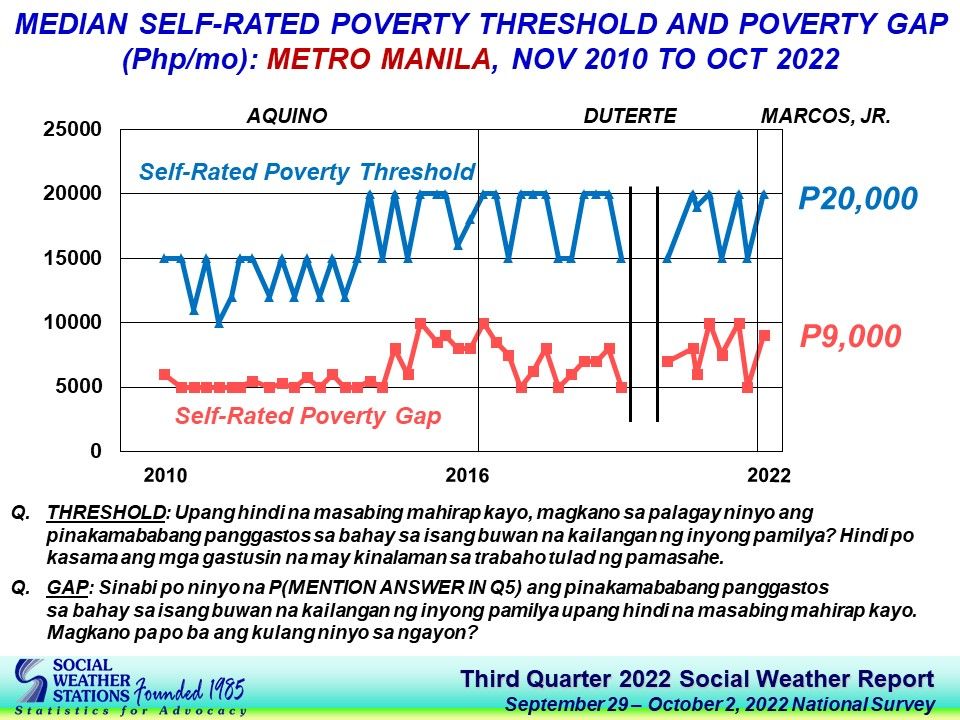
Table 6

Chart 11

Table 7

Chart 12
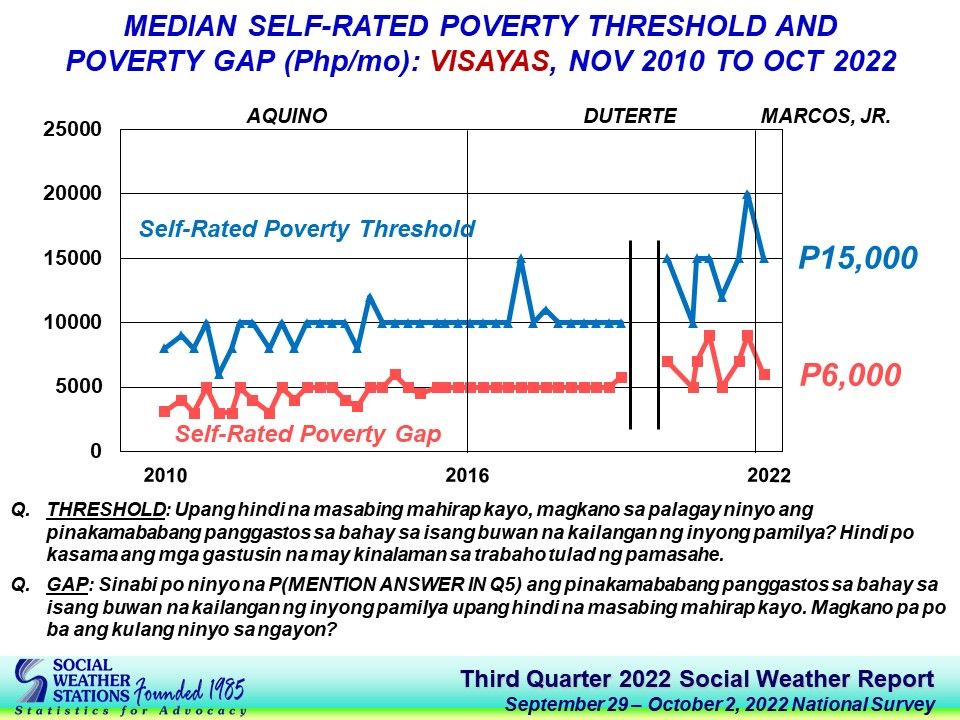
Table 8

Chart 13
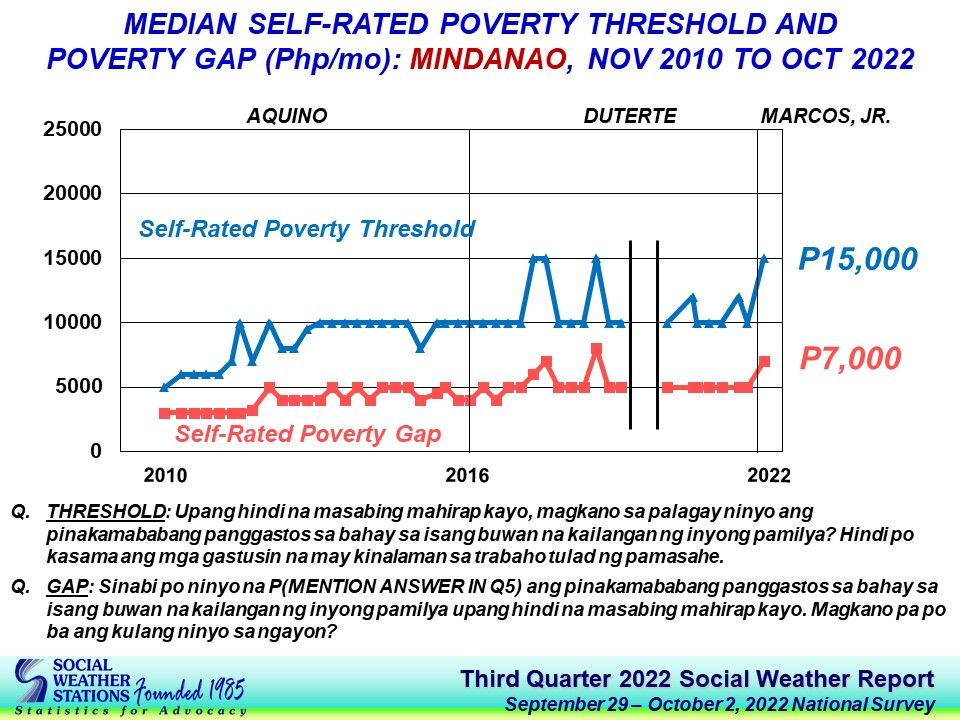
Table 9

Chart 14
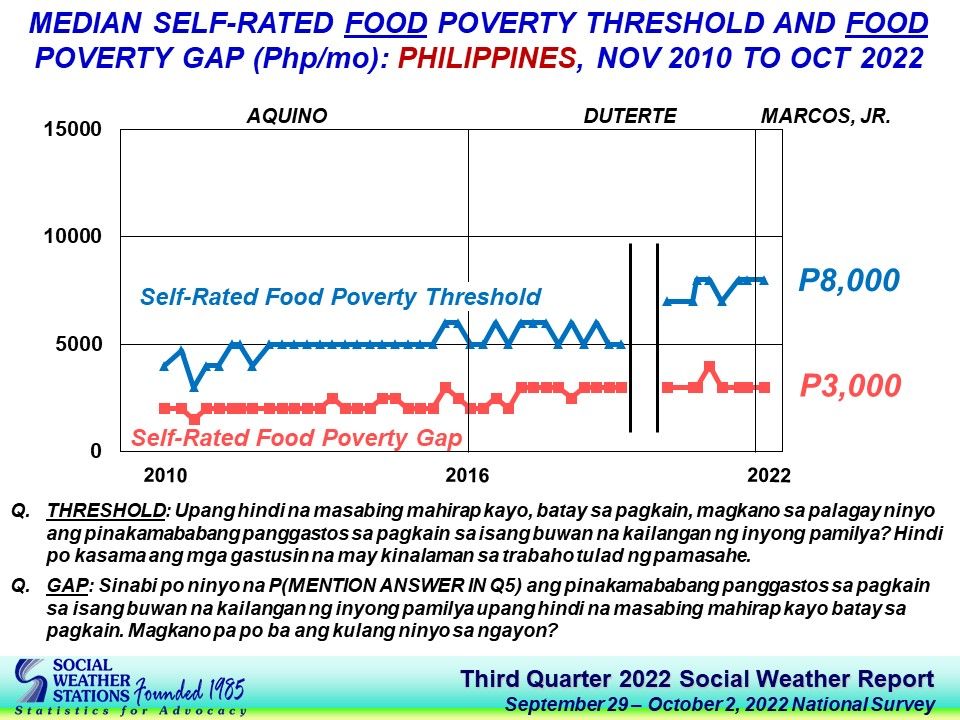
Table 10
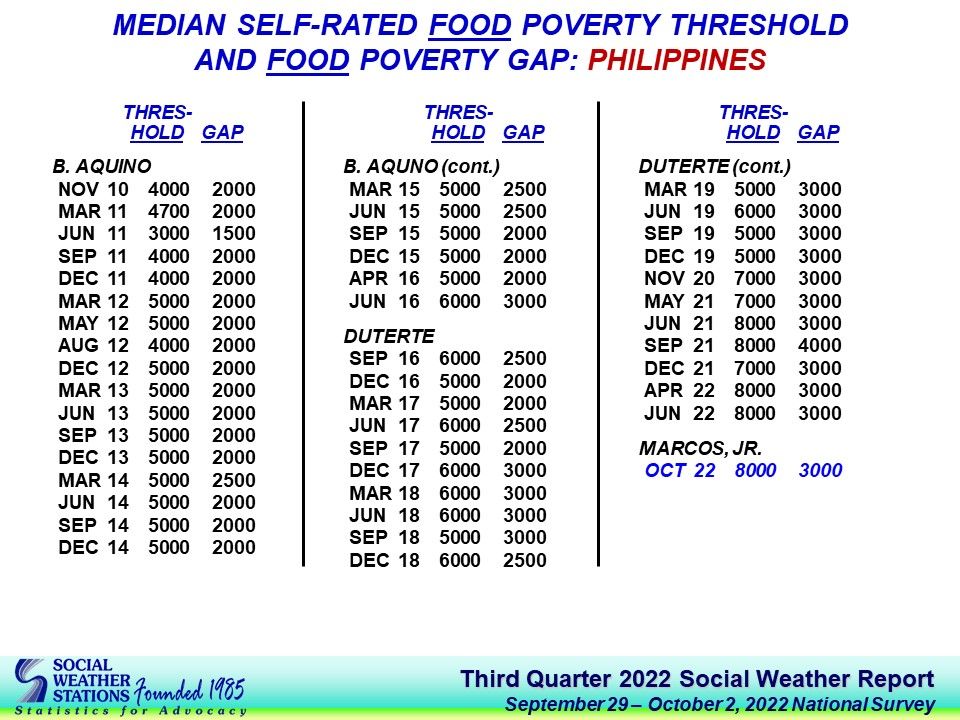
Chart 15
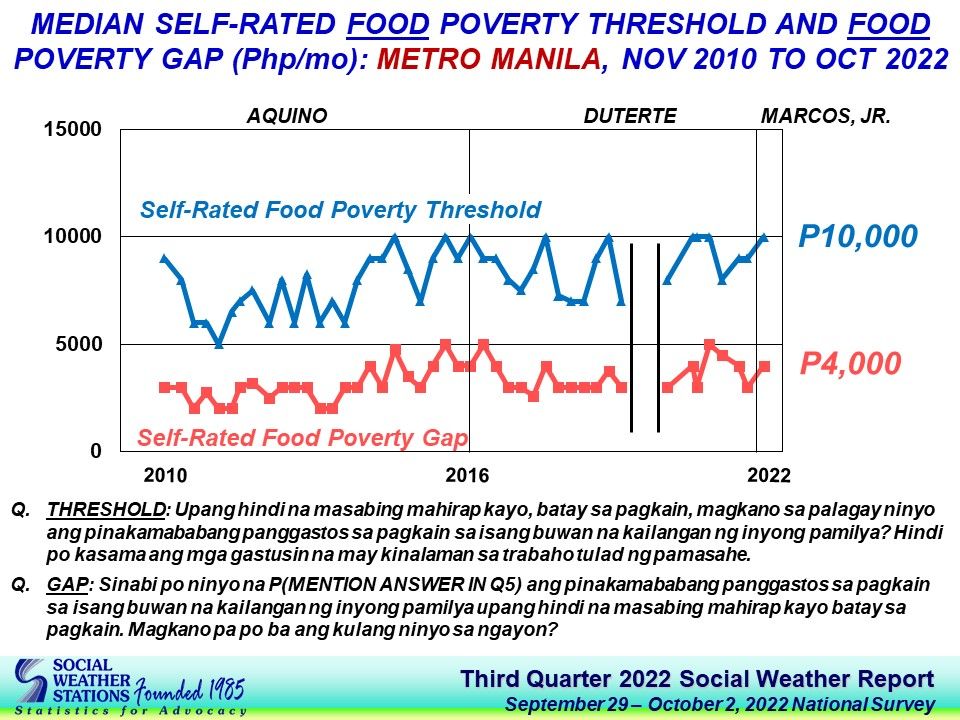
Table 11
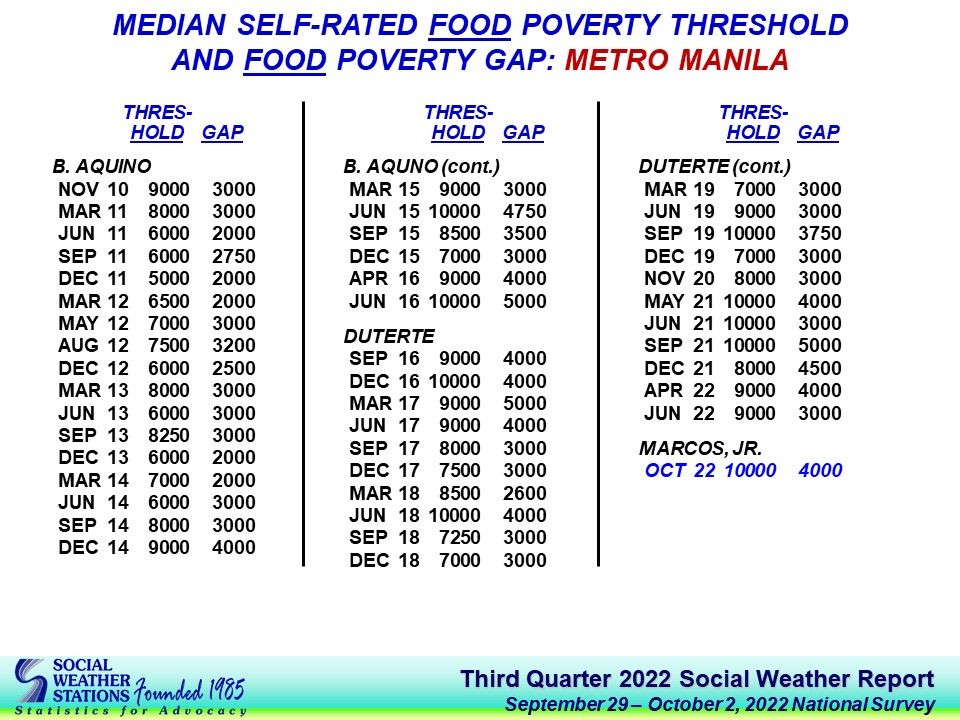
Chart 16
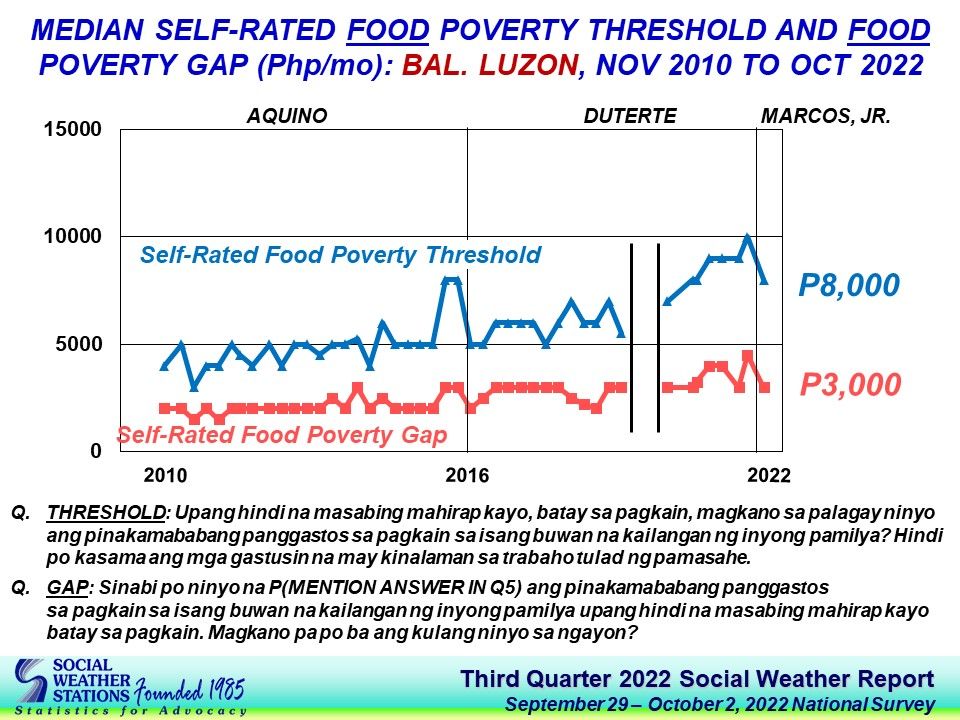
Table 12

Chart 17
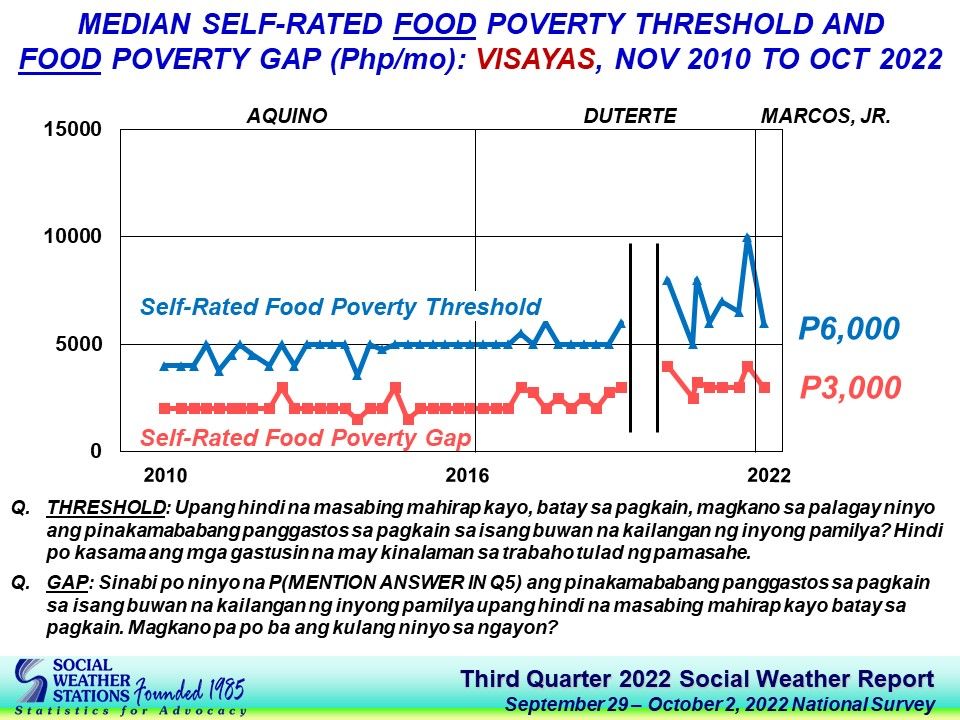
Table 13
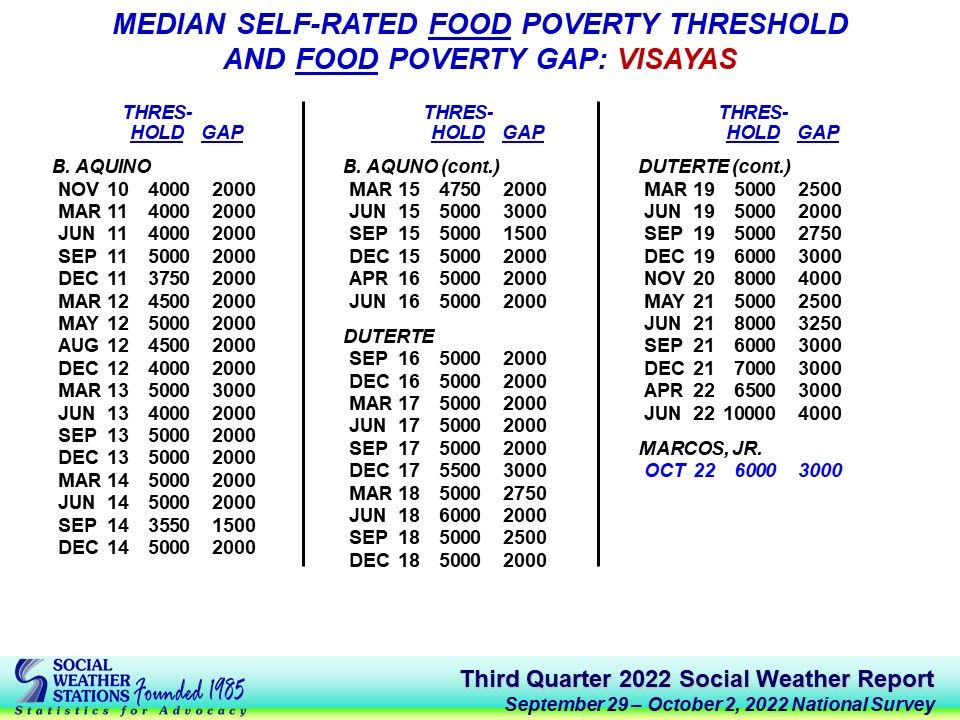
Chart 18
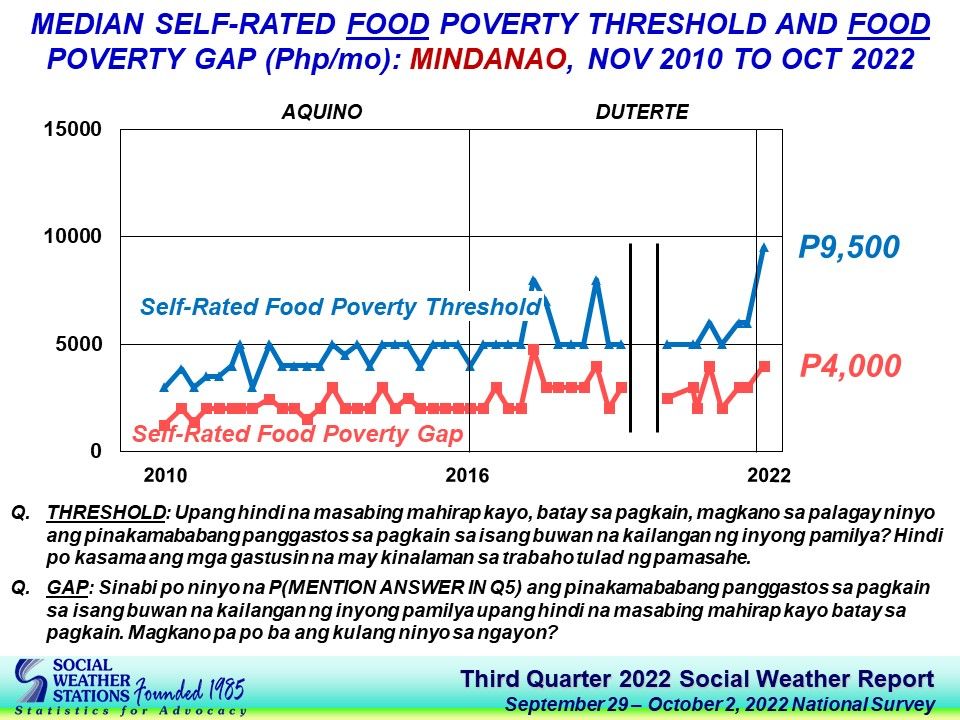
Table 14
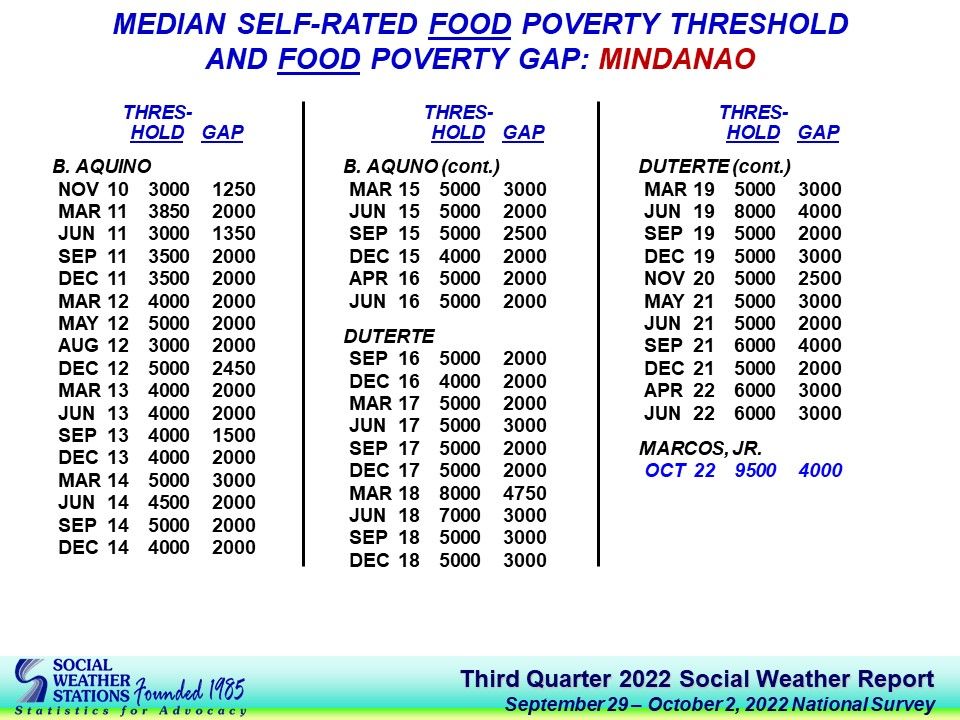
Chart 19
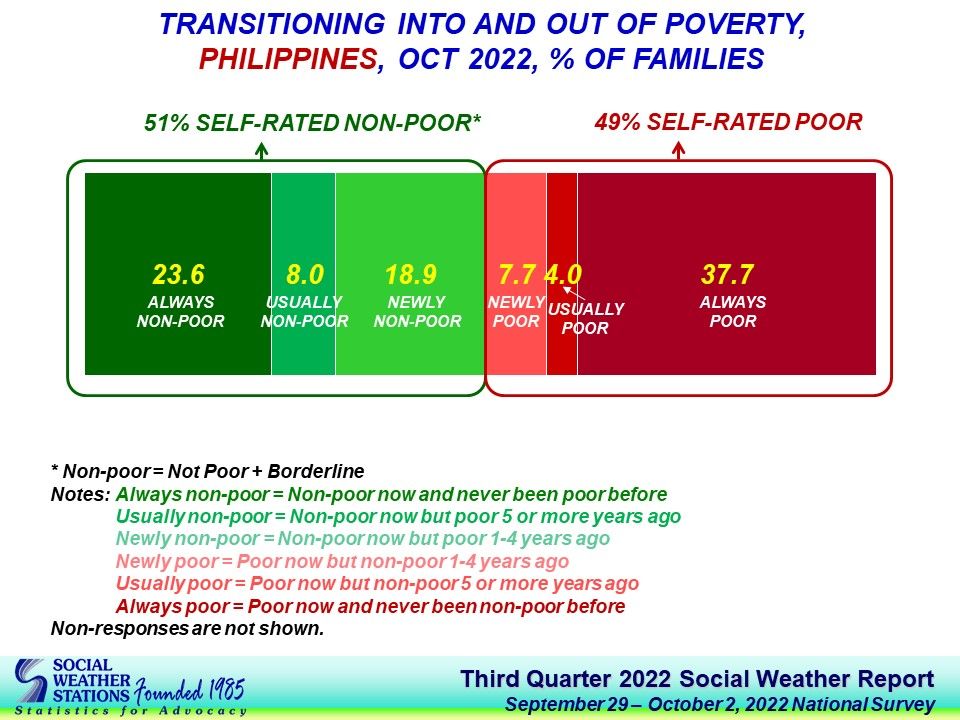
Table 15
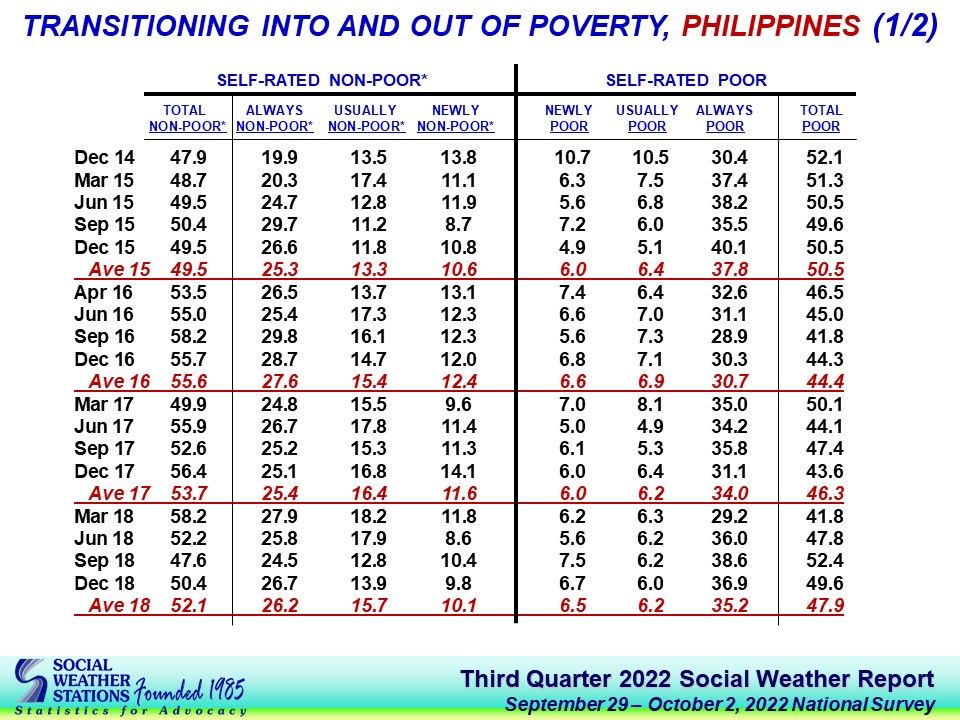
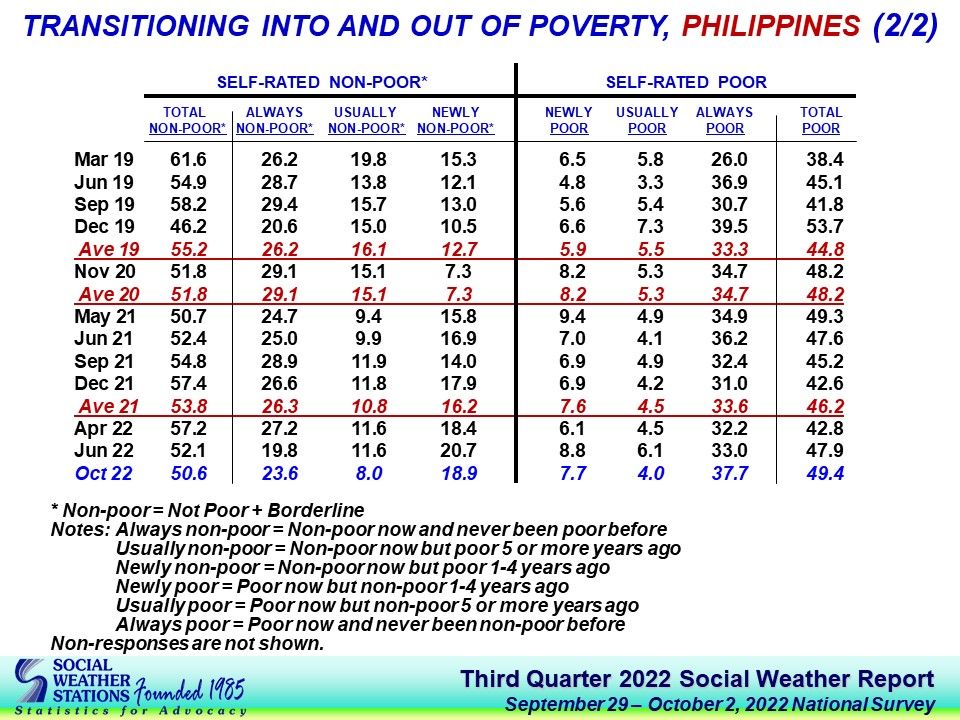
If you liked what you just read and want more of Our Brew, subscribe to get notified. Just enter your email below.

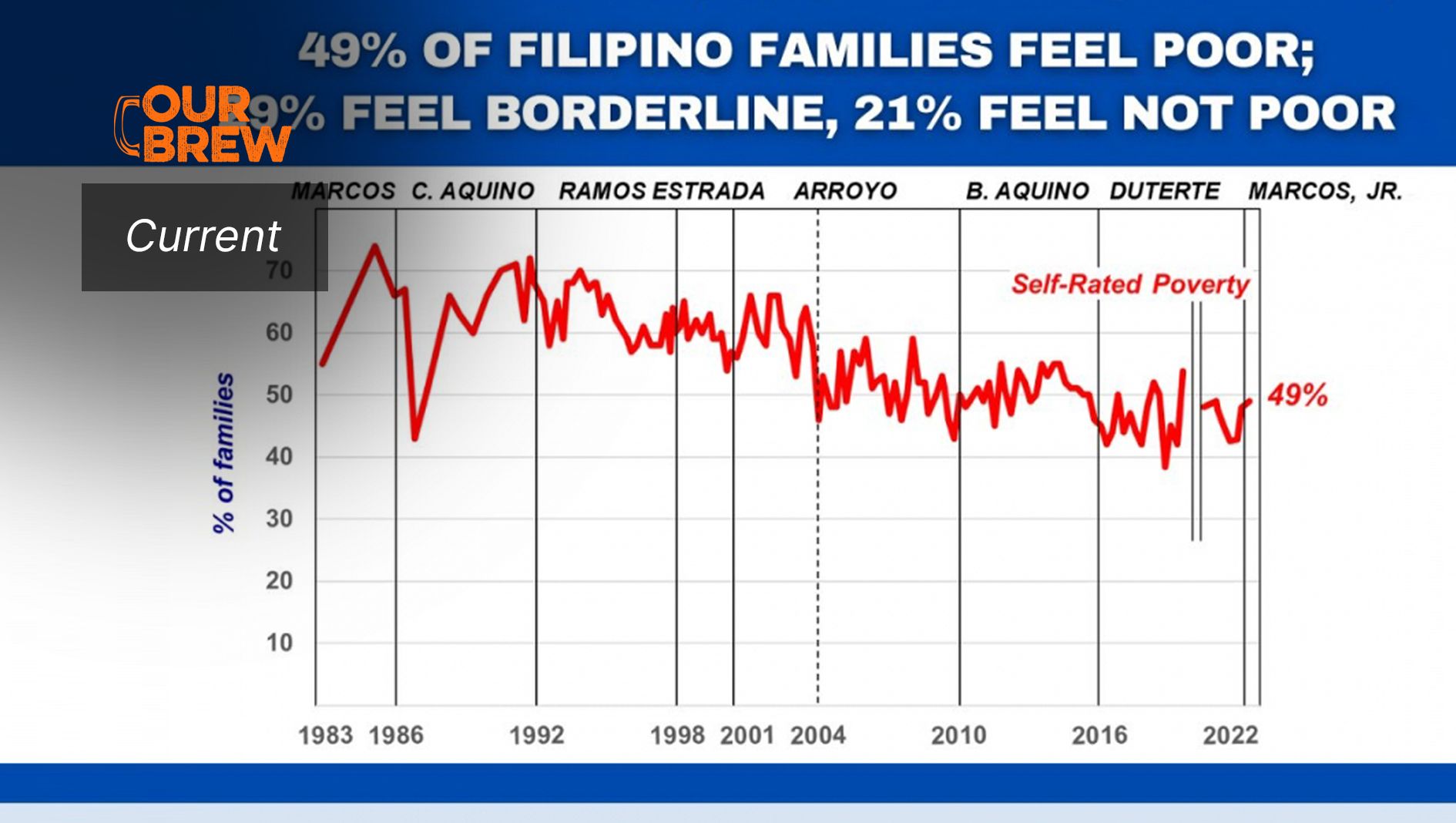
Related Posts
Supreme Court Rules Trump Can Rapidly Deport Immigrants to Libya, South Sudan and Other Countries They Aren’t From
Jun 25, 2025
Israel, Iran and the US: Why 2025 is a Turning Point for the International Order
Jun 19, 2025
People to VP Sara: “Answer Charges” - Stratbase-SWS
May 30, 2025